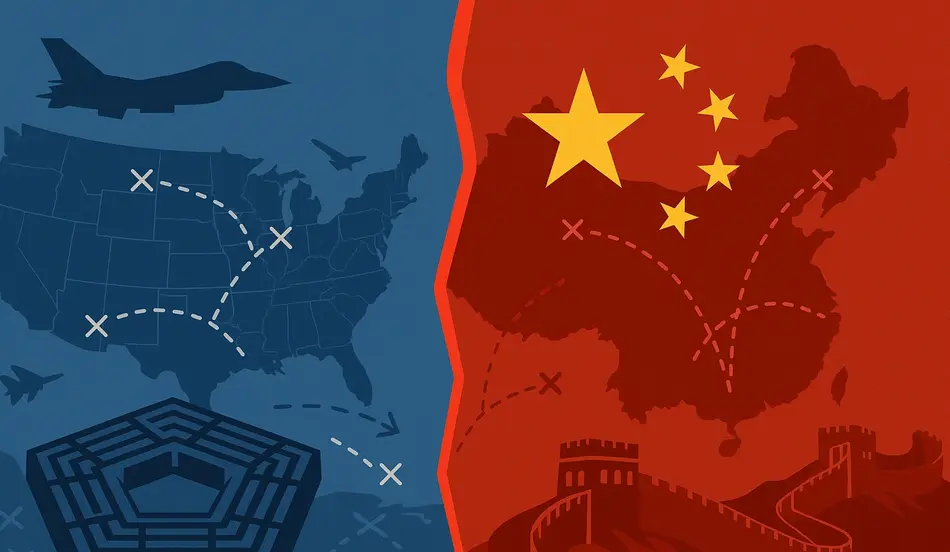America’s two-day war plan that terrifies China represents a strategic blueprint for how the United States could establish complete Pacific dominance within 48 hours, controlling the world’s most critical shipping lanes and preventing Chinese naval expansion. This comprehensive strategy leverages America’s technological superiority, alliance network, and strategic positioning to achieve what would typically require months of conventional military operations.
The plan centers on the fundamental principle that whoever controls the Pacific waters commands global trade, resources, and military dominance. With Taiwan producing over 60% of the world’s semiconductors and 90% of its most advanced chips, the stakes extend far beyond territorial control to encompass the entire global economy and technological infrastructure.
The strategy unfolds through a carefully orchestrated sequence of operations that transform the Pacific into an American-controlled maritime domain. From cyber warfare and satellite operations to submarine deployments and island-based missile systems, every element is designed to create an overwhelming advantage that makes Chinese victory mathematically impossible.
The plan’s effectiveness lies not just in military might, but in its integration of economic, technological, and diplomatic elements that create a comprehensive deterrent system. When faced with certain defeat, even authoritarian regimes choose strategic patience over inevitable destruction.
The Strategic Foundation: Controlling the Pacific Gateway
The foundation of America’s two-day war plan rests on the understanding that the Pacific is the gateway to global power. The region handles over $3 trillion in annual trade, making it the world’s most economically critical maritime domain. Control of these waters means control of global supply chains, energy flows, and economic prosperity.
The plan begins with the recognition that China’s naval expansion represents an existential threat to American interests. With 130 Chinese warships moving in formation across the South China Sea, including the advanced CNS Fujian supercarrier, the threat is immediate and overwhelming. However, America’s response is equally comprehensive and decisive.
The strategy leverages America’s unique advantages: technological superiority, alliance networks, and strategic positioning. By activating these assets simultaneously, the US can create a defensive network that spans from Japan to Australia, effectively controlling every major shipping route and naval approach in the region.
The plan’s success depends on speed and precision. Unlike conventional warfare that unfolds over months or years, this strategy achieves its objectives within 48 hours, presenting China with a fait accompli that cannot be reversed through military action.
Controlling the Pacific Gateway
With over $3 trillion in annual trade, the Pacific stands as the world’s most critical maritime domain. Just as global powers compete for strategic control, employers must secure the right talent to safeguard their future. Post your job on WhatJobs today and connect with professionals ready to strengthen resilience in times of uncertainty.
Post a Job Free for 30 Days →The Alliance Network: Converting Diplomatic Relationships into War Machines
America’s two-day war plan relies heavily on its extensive alliance network in the Indo-Pacific region. Decades of diplomatic relationships and security treaties are immediately converted into wartime logistics vehicles, creating a unified war machine with the industrial capacity of three continents.
The alliance activation begins with secure calls to key partners: Japan, South Korea, the Philippines, and Australia. Each nation’s response varies in tone but not in substance – whatever America needs, America gets. This is alliance politics at its most raw, where mutual security interests override individual concerns.
Japan’s role is particularly crucial, as the plan depends on access to Japanese bases and the activation of Article 9 provisions allowing collective self-defense. The seamless integration between American and Japanese forces, honed through countless exercises, suddenly becomes a formidable deterrent to Chinese aggression.
South Korean ports open their arms to American destroyers and cruisers, while Australian intelligence facilities transition to full wartime operations. The transformation from peacetime alliances to wartime coordination happens with remarkable efficiency, demonstrating the depth of these relationships.
The alliance network provides not just military support but also economic leverage. When these nations stand united against Chinese aggression, they represent a significant portion of the global economy, making any conflict economically devastating for China.
The Technological Edge: Cyber Warfare and Space Operations
America’s two-day war plan leverages cutting-edge technology to create advantages that China cannot match. Cyber Command unleashes operations that exist in a realm beyond conventional warfare, targeting enemy communication networks with cascading failures that appear random but are mathematically precise.
The cyber operations extend beyond simple disruption to sophisticated electronic warfare. Chinese military satellites find their uplinks jammed by signals so advanced they appear to be equipment malfunctions. GPS satellites receive new programming that selectively denies service to hostile forces while maintaining precision guidance for American weapons.
Space Force assets begin strategic electronic warfare operations that blind enemy surveillance systems while enhancing American capabilities. The battlefield expands from land, sea, and air to include orbital heights, where weapons and algorithms can defeat a military without firing a single shot.
The technological advantage extends to reconnaissance and intelligence gathering. Global Hawk drones with 30-hour missions map every vessel, installation, and movement across millions of square miles of ocean. AWACS aircraft establish aerial command posts that can interweave live drone feeds across time zones while remaining beyond enemy reach.
The Submarine Strategy: Controlling the Depths
America’s submarine fleet forms the backbone of the two-day war plan, with seven Los Angeles-class attack submarines receiving coordinates and vanishing beneath the waves. These submarines position themselves at strategic chokepoints that control access to the Pacific from Chinese waters.
The USS Hawaii settles into deep waters north of the Strait of Malacca, detecting every vessel that passes through the world’s most important shipping lane. The USS Virginia positions herself at the southern entrance to the South China Sea, effectively controlling access to ports that handle a third of global trade.
Ohio-class guided missile submarines, each carrying 154 Tomahawk missiles, position themselves for strikes that could destroy Chinese infrastructure within hours. The ocean depths become dominated by American technology and training that makes Chinese submarine commanders think twice about leaving port.
The submarine strategy creates an invisible barrier that prevents Chinese naval forces from operating freely in the Pacific. Any Chinese fleet attempting to reach the open ocean must pass through waters controlled by American submarines, making their movements predictable and vulnerable.
The Island Strategy: Forward Operating Bases
The plan’s most audacious element involves transforming Japanese islands into forward operating bases that control access to Taiwan. Marine Expeditionary Units launch from Okinawa in amphibious assault ships, targeting the Ryukyu Islands chain that stretches from Japan toward Taiwan.
These islands – Mako, Ishigaki, and tiny coral outposts like Yonaguni – sit within 70 miles of Taiwan’s coast and represent geographic chokepoints through which any Chinese fleet must pass to reach the open Pacific. Control of these islands means control of the shipping lanes that carry more than $3 trillion in trade annually.
The amphibious operations are choreographed under the assumption that Chinese ballistic missiles will attempt to turn the performance into a tragedy. Speed is of the essence as Marines storm the beaches and transform these tiny outposts into forward missile bases ready to sink any Chinese warship attempting to push through the Taiwan Strait.
The transformation happens with remarkable efficiency. Pre-fabricated air traffic control towers arrive by helicopter, while Patriot missile batteries set up defensive perimeters. Fuel bladders support fighter operations, while communications equipment establishes satellite links connecting these tiny outposts to global command networks.
The Economic Warfare: Collapsing Chinese Calculations
America’s two-day war plan includes a sophisticated economic warfare component that makes Chinese victory economically impossible. The strategy leverages the interconnected nature of the global economy to create pressure points that force Chinese leadership to choose between military action and economic survival.
Lloyd’s of London announces it will no longer insure vessels transiting disputed waters, immediately affecting global shipping patterns. Asian stock markets plummet as investors realize a shooting war means supply chain collapse. Samsung warns its chip production could halt within days.
The economic warfare extends to supply chain disruption. Container ships receive polite but firm recommendations about route selection. Oil tankers request naval escorts through waters that were international yesterday but feel increasingly American today. The global economy adapts to American naval supremacy with the efficiency of markets responding to new realities.
The economic pressure creates a feedback loop that makes Chinese military action increasingly costly. As the global economy begins shutting down before the first shot is fired, Chinese leadership faces the reality that military victory would mean economic devastation.
Frequently Asked Questions
America’s two-day war plan that terrifies China – what is it?
America’s two-day war plan that terrifies China is a strategic blueprint for how the US could establish complete Pacific dominance within 48 hours, controlling global trade and preventing Chinese naval expansion through technological superiority and alliance networks.
How does the plan control the Pacific in just 48 hours?
The plan uses submarine deployments at strategic chokepoints, island-based missile systems, cyber warfare, space operations, and alliance coordination to create an overwhelming advantage that makes Chinese victory mathematically impossible.
What role do alliances play in the strategy?
Alliances with Japan, South Korea, Australia, and the Philippines are immediately converted into wartime logistics vehicles, creating a unified war machine with the industrial capacity of three continents and technological sophistication of the world’s most advanced military powers.
How does technology give America the edge?
America’s technological edge includes cyber warfare capabilities, space-based electronic warfare, advanced submarine technology, stealth aircraft, and integrated missile defense systems that China cannot match or counter effectively.
What is the island strategy component?
The island strategy transforms Japanese islands into forward operating bases that control access to Taiwan, creating geographic chokepoints through which any Chinese fleet must pass to reach the open Pacific.
How does economic warfare factor into the plan?
Economic warfare includes disrupting global shipping insurance, causing stock market crashes, and forcing supply chain disruptions that make Chinese military action economically devastating before any shots are fired.
A Real-World Example: The Defense Analyst’s Perspective
Dr. Sarah Chen, a senior defense analyst at the Center for Strategic and International Studies, has spent years studying America’s two-day war plan that terrifies China. “The plan represents a fundamental shift in how we think about military strategy,” she explains. “It’s not about winning a war through attrition, but about preventing war through overwhelming capability demonstration.”
Dr. Chen’s research focuses on the psychological and economic components of the strategy. “The brilliance of the plan lies in its integration of military, economic, and diplomatic elements,” she says. “It doesn’t just defeat China militarily; it makes military action economically and strategically irrational.”
The plan’s effectiveness, according to Dr. Chen, depends on China’s rational calculation that retreat is preferable to destruction. “When faced with certain defeat, even authoritarian regimes choose strategic patience over inevitable humiliation,” she explains. “The plan creates a situation where China’s best option is to de-escalate and save face.”
Dr. Chen’s analysis reveals the plan’s broader implications for global security. “The demonstration of American resolve and capability serves as a deterrent to other potential adversaries,” she says. “The message is clear: America’s technological edge and alliance network make military confrontation with the United States a losing proposition.”
The plan’s success, Dr. Chen argues, depends on maintaining America’s technological superiority and alliance relationships. “The strategy is only as effective as the capabilities that support it,” she explains. “It requires continued investment in technology, training, and alliance maintenance to remain viable.”
Dr. Chen’s research highlights the plan’s potential to reshape global power dynamics. “If successful, the plan would establish American dominance in the Pacific for decades to come,” she says. “It would prevent Chinese naval expansion and maintain the current international order that has brought peace and prosperity to the region.”
Don’t Underestimate the Stakes of Pacific Dominance
America’s two-day war plan that terrifies China represents a fundamental shift in military strategy, where prevention through overwhelming capability demonstration replaces traditional warfare approaches. The plan’s success depends on America’s ability to maintain its technological edge, alliance relationships, and strategic positioning in the Indo-Pacific region.
The stakes extend far beyond military dominance to encompass global economic stability, technological leadership, and the preservation of the international order. With Taiwan producing the world’s most advanced semiconductors, control of the Pacific means control of the global economy’s technological foundation.
The plan’s effectiveness lies in its ability to present China with a fait accompli that cannot be reversed through military action. By the time Chinese leadership realizes the full scope of American capabilities, their options are limited to retreat or face certain defeat.
The future of global security depends on America’s ability to maintain the technological superiority and alliance relationships that make this strategy viable. The plan represents not just a military strategy, but a comprehensive approach to maintaining peace and stability in the most critical region of the world.
Ready to understand the strategic implications of Pacific dominance? Learn how to analyze global security trends and position yourself for success in an era of shifting power dynamics.




